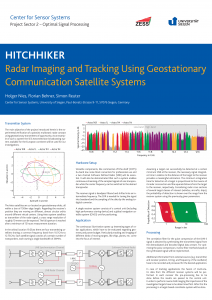The administration of the University of Siegen has supported our team by giving us access to the roof of the ZESS building to carry out our experiments. The picture shows the state at the beginning of the project. Now we can start placing our antennas …

In contrast to our high-end HITCHHIKER receiver system, we started investigating in a low cost and permanent available setup for the acquisition of radar signals. We are looking for a solution for continuous observation of small local areas which cannot be satisfied by the current satellite programs. Finally, we decided to use the signals transmitted by geosynchronous broadcasting satellites (e.g., SES-ASTRA and EUTELSAT HOT BIRD) as source for our passive receiver system. The receiver is based on a two channel Software Defined Radio (SDR) for tuning the desired signal to baseband and the sampling of the data by the analog-to-digital converter.
The main objective of the DFG funded project is the experimental verification of a parasitic multistatic radar concept using geostationary transmitters of opportunity. Further information about the project and system design you will find in the poster below.

The design of the HITCHHIKER transmitter component was finally completed.

Model of the HHTX system




